Understanding search volume is critical for online success in the fast-paced world of SEO. It’s not just about knowing how often a keyword is searched; it’s about strategically using this data to enhance visibility and target the right audience. Tools like Google Keyword Planner, Google Trends, Ahrefs, Semrush, and Moz are essential for any digital marketer’s toolkit, offering insights into keyword popularity, competitive analysis, and market trends. Mastering these tools is key to developing a robust and effective SEO strategy.
What is Search Volume?
Search volume refers to the number of times a keyword or query is searched for in a search engine within a given period. This metric is crucial for understanding the popularity and relevance of keywords among internet users, helping businesses and content creators align their strategies with user interests and online search behaviours.

Search volume isn’t just a number. It’s a gateway to understanding user intent and market trends. A keyword with a high search volume indicates a significant interest in that topic or product. This information is vital for anyone involved in SEO, content creation, or digital marketing, as it guides them in choosing the right keywords and queries to target. By focusing on keywords with substantial search volumes, websites stand a better chance of appearing in front of a larger audience, increasing their visibility and potential for engagement.
Moreover, search volume data is often categorised based on different regions and timeframes. This means you can see how often a term is searched in different areas and how its popularity varies. For instance, seasonal products or events will show fluctuating search volumes throughout the year. This geographical specificity aids in tailoring content and marketing strategies to specific audiences and times, maximising relevance and impact.
Understanding search volume is also crucial for evaluating keyword competition. Generally, keywords with higher search volumes are more competitive, meaning more websites try to rank highly for them! This requires a strategic approach to SEO, where you balance targeting high-volume keywords for maximum exposure and lower-volume, niche keywords for less competition.
How Does Search Volume Impact SEO?
Search volume plays a hugely important role in SEO. It acts as a compass, guiding SEOs, digital marketers, and other content creators in identifying which keywords or phrases are most popular among users.
A higher search volume indicates a greater interest in a particular product or topic, making those keywords invaluable for driving organic traffic. When a website matches its content with these high-volume search terms, it significantly increases the likelihood of appearing on the first page of the SERPs. This visibility is crucial! Websites that rank on the first page attract the vast majority of clicks, leading to increased engagement, potential conversions, and more revenue.
Websites that rank in the top organic position within a SERP are estimated to grab around 40% of the total clicks! That’s huge!
It’s not just about chasing the most popular terms. High search volume keywords are often hugely competitive, meaning many websites compete for a spot on the first page. This scenario shows the need for a balanced approach in an SEO strategy, where one combines high-volume keywords with long-tail, niche keywords with lower competition levels.
While attracting much fewer searches, these niche keywords are often more specific and can drive highly targeted traffic to a site.
By focusing on high and low search volume keywords, websites can achieve a more diversified and effective SEO strategy, helping them rank for a range of terms and meet the total needs of their audience. This balance is key to building a robust online presence and achieving long-term success in the digital marketplace.
What are the Top Search Volume Tools for 2025?
To round off this post, we will detail the top search volume tools that your business should be using in 2025 and well beyond!
Google Keyword Planner
Google Keyword Planner is a hugely valuable tool for monitoring search volume, primarily because it provides direct insights from Google’s search volume data. It’s a go-to resource for marketers and SEOs like myself to gauge keywords’ popularity and understand user search trends. By offering data on average monthly searches for specific keywords, Google Keyword Planner helps identify high-volume terms that can drive traffic and niche keywords with lower competition. Additionally, it provides historical search data and forecasts future search trends, allowing for strategic planning in SEO and content marketing efforts.
To use Google Keyword Planner to find the search volume of different keywords and queries, you need to start by accessing the tool through a Google Ads account.
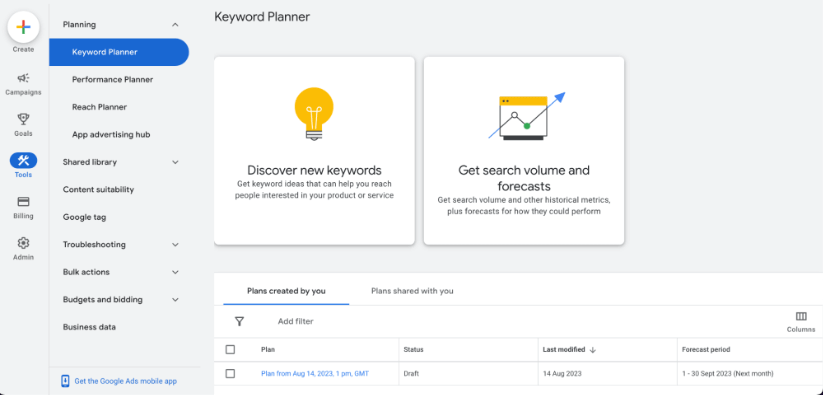
Once logged in, you can input keywords or phrases relevant to your business or content using the ‘Discover New Keywords’ option. The tool then generates a list of related keywords and important metrics like average monthly searches, competition level, and top-of-page bid estimates. You can customise your search by:
- Language
- Location
- Time Period
To get more precise data. This functionality lets users pinpoint the most effective target keywords for their SEO strategies, tailored to their target audience and market.
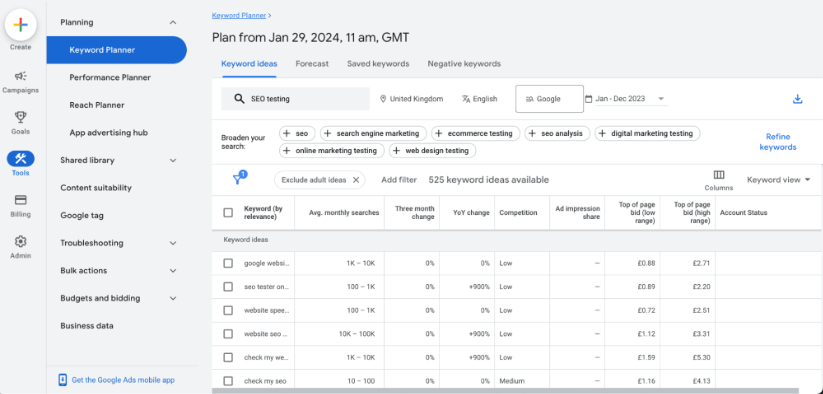
Regarding pricing, Google Keyword Planner is a free feature within Google Ads. So you do not need to spend any money to access it. However, it’s important to note that having an active Google Ads campaign can influence the detail and range of data you receive!
Without an active campaign, the data is often given in ranges (1K-10K monthly searches) rather than specific numbers. Users with active Google Ads campaigns typically have access to more detailed data, offering finer insights into search volumes. This tiered access makes the tool flexible, catering to small and large businesses!
Google Trends
Google Trends is another powerful tool for monitoring search volume, providing a unique perspective on the popularity levels of keywords over time. Unlike traditional search volume tools that offer data in a numbered format, Google Trends visualises the popularity of search terms on a scale from 0 to 100.
This feature allows users to compare different keywords and see how interest in specific topics has evolved. It’s especially useful for identifying seasonal trends, emerging topics, and regional variations in search interest. It makes it an invaluable resource for marketers and content creators looking to align their strategies with current and evolving user interests.
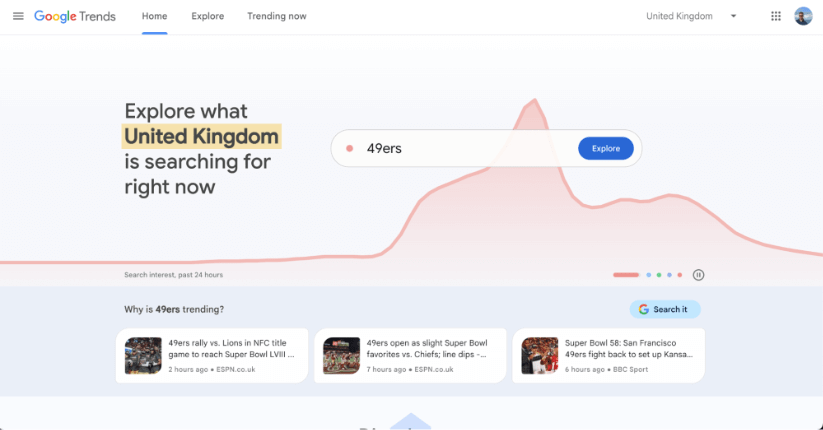
To use Google Trends to find search volume, begin by visiting the Google Trends site. Here, you can enter a keyword phrase into the search bar to see its interest over time, represented in a graph.
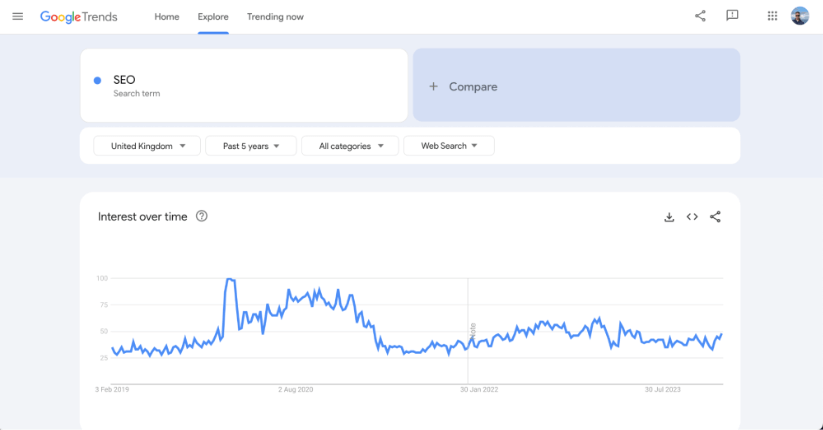
The tool allows you to refine the data by time range, location, category, and search type (web searches, image search, YouTube search, etc). It also provides related topics and queries, offering insights into related areas of interest. Google Trends doesn’t give exact search volume numbers but shows the relative popularity of a term, which can be especially useful for comparing the performance of multiple keywords or monitoring the rise and fall of specific trends.
One of the most attractive aspects of using Google Trends is that it’s completely free! This makes it accessible to anyone with internet access, from individual bloggers to large businesses. The lack of a direct cost encourages experimentation and exploration, allowing users to dive deeply into the data without any financial constraints. This open-access approach decentralises data, allowing everyone to harness the power of search trend analysis for their SEO and marketing strategies.
Ahrefs
Ahrefs stands out as a robust tool for monitoring search volume, catering especially to SEO professionals and marketers who require detailed keyword data. Unlike basic tools like Google Keyword Planner and Google Trends, Ahres offers comprehensive insights into keyword search volume, keyword difficulty, click-through rates, and the number of clicks a keyword receives.
This level of detail is crucial for understanding how often a term is searched for, the potential traffic it can drive, and its ranking competitiveness. Ahrefs’ extensive database and analytical capabilities make it a powerhouse for in-depth SEO research and strategy development, particularly for those looking to build or refine their keyword targeting.
Using Ahrefs to find search volume involves heading to its ‘Keywords Explorer’ feature.
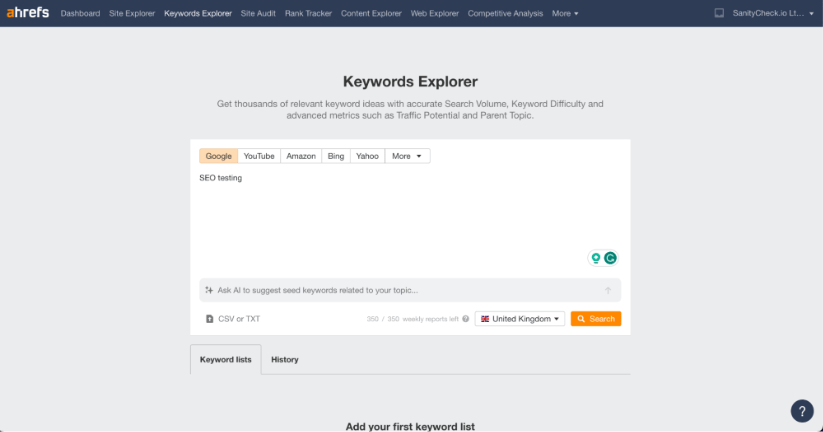
Once you input a keyword into this tool, it gives you a lot of data, including search volume, keyword difficulty score, and an estimate of how many clicks you can expect from Google’s top 10 search results.
Additionally, it shows the keyword’s search volume trend over the 10 years (ish), providing insight into seasonal fluctuations or growing trends. Ahrefs also offers related keyword suggestions, complete with their metrics, allowing users to explore alternative or supplementary keywords for their SEO strategies.
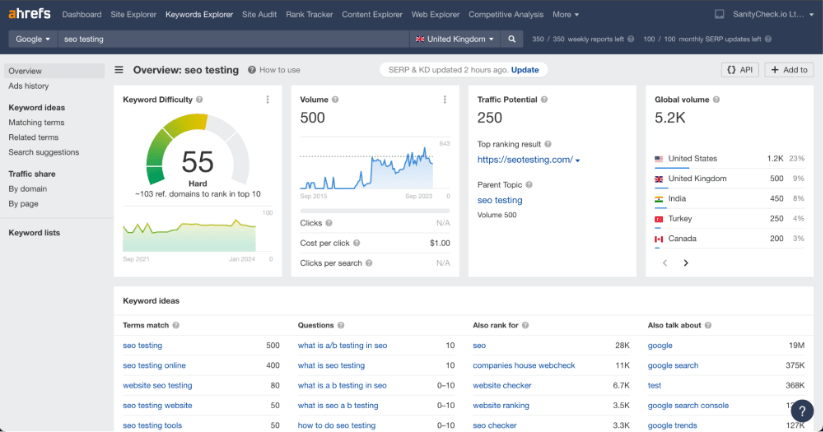
This functionality is handy for identifying less obvious keywords that offer valuable traffic opportunities with less competition.
Ahrefs is a paid tool. Its pricing plan is as follows:
- Lite at £79 per calendar month.
- Standard at £159 per calendar month.
- Advanced at £319 per calendar month.
- Enterprise at £799 per calendar month.
Semrush
Semrush is another highly acclaimed tool for monitoring search volume, widely recognised for its extensive keyword research capabilities and competitive analysis features. It offers a treasure trove of data on keyword search volumes, trends, keyword difficulty, and the potential for organic and paid search traffic.
What sets Semrush apart is its ability to provide insights into how often terms are searched and analyse competitors’ keyword strategies. This makes it an indispensable tool for businesses and SEO professionals looking to gain an edge in the SERPs by understanding both the market demand, through search volume, and the competitive landscape.
To use Semrush for finding search volume, you must use their ‘Keyword Overview’ tool. Entering a keyword into this tool gives you detailed information, including its monthly search volume, keyword difficulty score, and the number of results on Google.
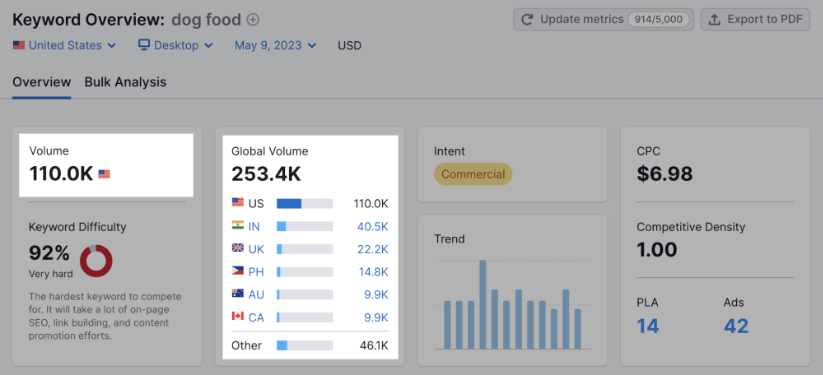
Additionally, it provides valuable insights like trend data, which shows the keyword’s search volume over time, and related keywords, complete with their metrics. For a more comprehensive analysis, the ‘Keyword Magic Tool’ offers an extensive database of keywords categorised by topic.
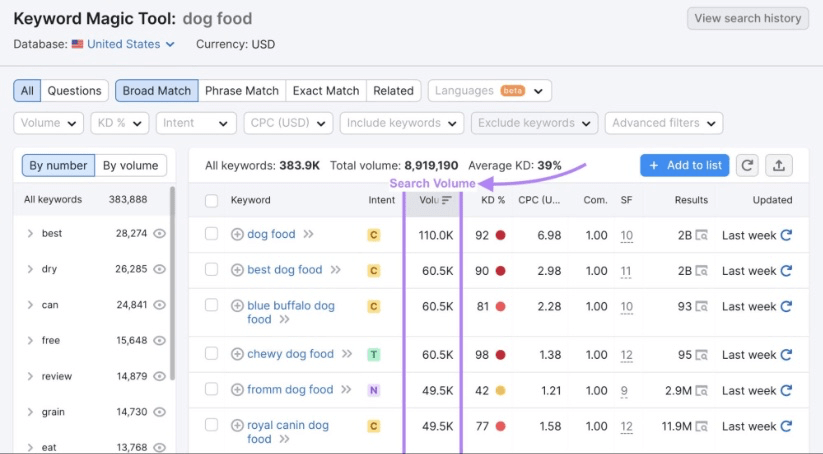
This helps users to find long-tail keywords and refine their keyword strategies. These features are instrumental in uncovering high-potential keywords and understanding the broader context of search trends related to specific topics or industries.
Semrush is a paid tool. Its pricing plan is as follows:
- Pro sits at $129 per calendar month.
- Guru sits at $249.95 per calendar month.
- Business sits at $499.95 per calendar month.
Moz
Finally, we turn to Moz! It’s a tool favoured for its user-friendly interface and reliable keyword data. It’s an excellent resource for both SEO beginners and seasoned professionals, offering detailed insights into:
- Keyword Search Volumes
- Keyword Difficulty
- Organic Click-Through Rates
Moz’s ‘Keyword Explorer’ tool is especially notable for its accuracy in estimating search volume and for providing a Keyword Difficulty score, which helps users gauge how challenging it would be to rank for a particular keyword. Moz offers SERP analysis and suggests related keywords, making it a comprehensive tool for developing effective SEO strategies and understanding keyword trends over time.
To use Moz for finding search volume, start by accessing the ‘Keyword Explorer’ tool. This allows you to enter a keyword and receive a wealth of information, including monthly search volume, difficulty, organic CTR, and priority (a combination of all these metrics). Moz also displays a list of related keywords, along with their respective metrics, and provides SERP analysis, which shows the current top-ranking pages for a given keyword.
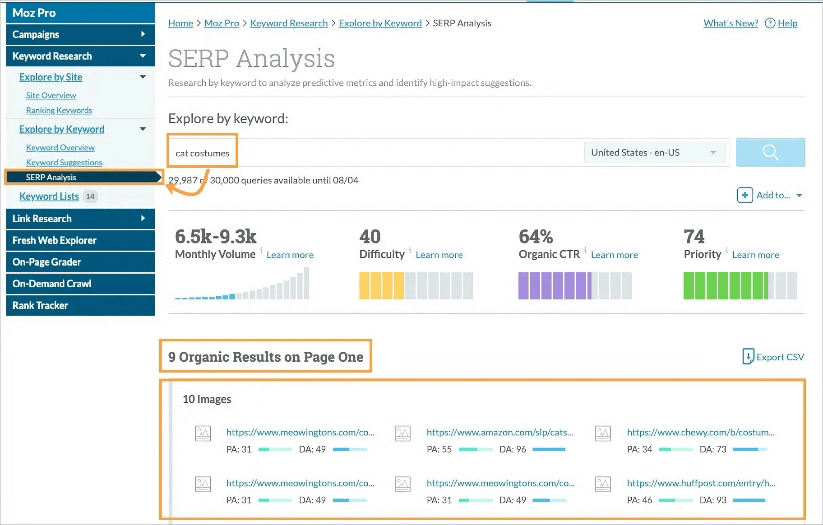
This feature is useful for understanding the content that performs well in search results.
Moz is a paid tool. Its pricing plan is as follows:
- Standard is listed at $79 per calendar month.
- Medium is listed at $143 per calendar month.
- Large is listed at $239 per calendar month.
- Premium is listed at $479 per calendar month.
Wrapping Things Up
In summary, understanding and leveraging search volume is fundamental to a successful SEO strategy. It’s not merely about tracking the frequency of keyword searches; it’s about unlocking insights into user intent, market trends, and competitive landscapes.
Tools like Google Keyword Planner, Google Trends, Ahrefs, Semrush, and Moz offer a spectrum of functionalities to navigate these waters effectively. Each tool’s unique features and data points equip digital marketers with the necessary information to make informed decisions.
As the digital landscape continues to evolve, utilizing these tools will be key to maintaining and enhancing online visibility and relevance. Whether you’re a novice or an expert in the SEO field, harnessing the power of search volume through these tools is essential for crafting strategies that resonate with your audience and drive success.
If you want to dive deeper into SEO testing in 2025 and beyond, then SEOTesting might be your tool! We are running a 14-day free trial with no credit card information required to sign up, so give the tool a try today! Or visit our website, seotesting.com, for more information.


